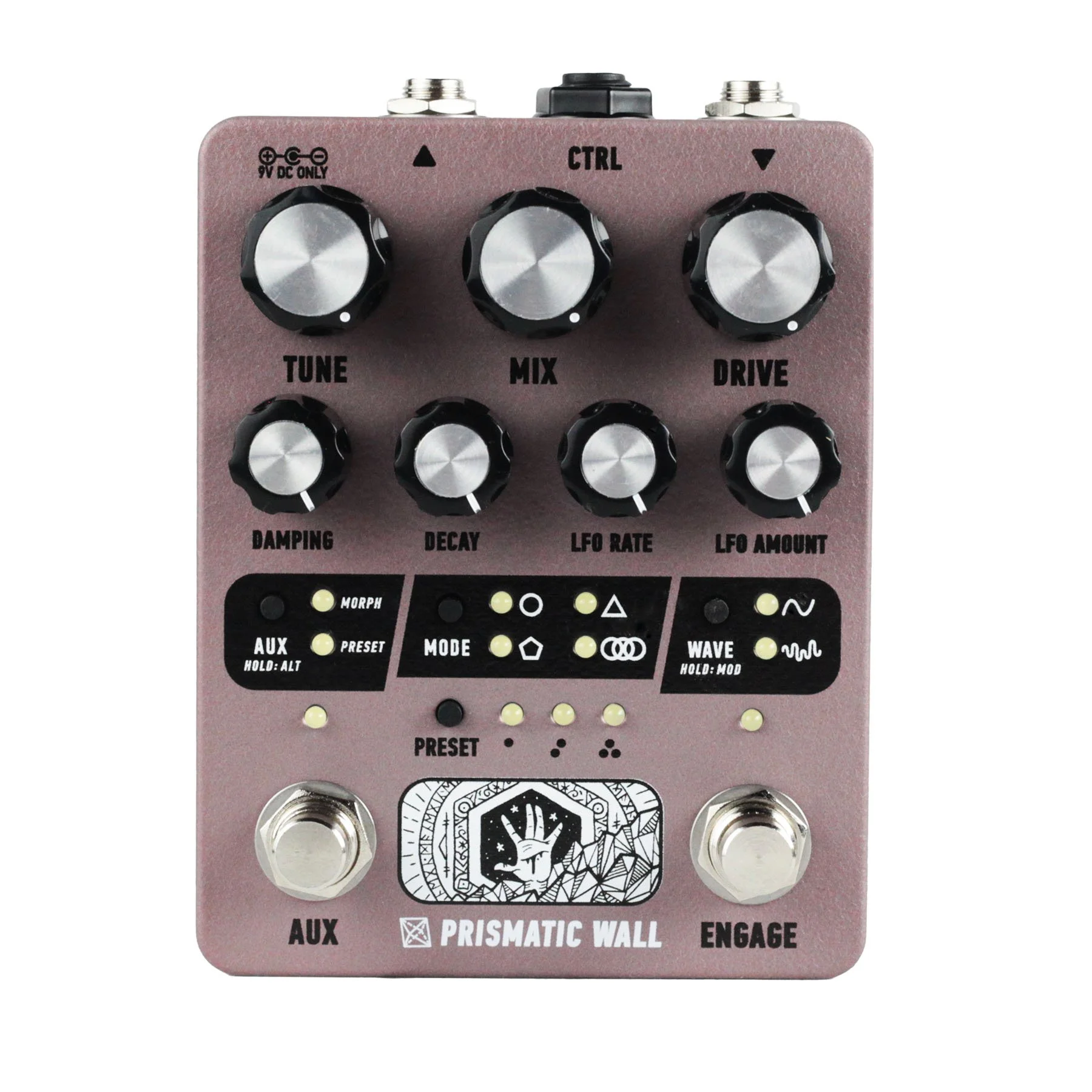Prismatic Wall
Prismatic Wall
Prismatic Wall is a sympathetic resonator designed to transmute incoming sounds into the vibrations of an illusory bank of tuned strings. Part reverb and part synthesizer, its metallic yet warm timbres span from the subtle harmonic aura of a third bridge to the rich chromatic suspensions of a grand piano. The simulated vibrations form a sustaining spectral extension of your instrument that retains a tangible physicality despite its surrealist underpinnings. The resonances are reactive in nature: playing in tune excites specific pitches, while percussive attacks excite all the strings in tandem.
Prismatic Wall utilizes a physical string model formed by tuned delay lines. Tuning is achieved by varying the sample rate of the system, manipulating the physical model in decidedly non-physical ways. The Mode selector determines the interval spacing between strings, with each configuration carefully selected to maintain a sense of harmonic ambiguity. Damping and Decay change the brightness and sustain of the strings, ranging from short plucks to infinite drones.
The hardware combines primitive DSP with analog saturation and filtering for a sonic character untethered from a particular era. A fully digital user interface enables all parameters to be controlled via MIDI, saved as presets, and even modulated by the onboard LFO. In addition, the Morphing function enables controllable transitions between two distinct settings via the Aux footswitch or an expression/CV source.
Prismatic Wall is a distinct instrument in its own right, a device that refracts musical intent into multifaceted harmonic colors. Will you traverse its intricate layers?
Please sign up for our email newsletter to be informed about upcoming batches.
-
• Analog/digital hybrid signal processing (24 bit, variable sample rate) paired with analog filtering and emphasis, for low noise with a colorful character
• High headroom analog dry path and mixer
• Comprehensive digital control of every function using a 32-bit processor system that seamlessly integrates with the analog signal path.
• Performance-friendly expression morphing functionality with intelligent momentary/latching behavior and adjustable rise/fall times
• Full MIDI implementation (CCs and presets) for all parameters, analog and digital
• 16 preset slots: 3 via the front panel, the rest via MIDI
• CTRL jack for MIDI, expression, and CV input
• Multi-mode, assignable LFO with periodic and random waveforms
• Updatable firmware via MIDI Sysex messages
-
Bypass switching: Electronic bypass with buffered or Trails modes.
Input impedance @ 1kHz: 1MΩ
Output impedance @ 1kHz: 1kΩ
Power: 9VDC, 2.1mm center negative barrel. Current draw is 120mA max.
We recommend a regulated, isolated power supply rated for 200mA minimum to accommodate startup surges. The DC input is protected against reverse polarity and over-voltage up to 24V. Our pedals do not accept batteries.
All Electronic Audio Experiments pedals come with a warranty tied to the original owner.
-
For complete details, check out the manual and the quick reference guide.
Tune: adjusts the pitch of the resonators across a four octave range
Mix: wet/dry blend
Drive: sets the signal level driving the resonator, with overload at higher settings
Damping: high frequency decay of the resonators
Decay: overall decay time of the resonators; at its upper range also adds analog feedback to create infinite drones
LFO Rate: LFO speed; modulates Tune by default
LFO Amount: LFO amplitude
Mode Button: selects between four string spacing modes: single w/ harmonic overtones, stacked neutral thirds, stacked fifths, and chromatic
Wave Button: selects the LFO waveform between periodic and random modes. Long press to access the Mod page.
Engage Footswitch: activates the pedal. Long press to toggle trails/standard bypass modes.
Aux Footswitch: the footswitch behavior depends on the Aux button setting. In Morph mode, Aux will jump between two distinct knob settings with intelligent momentary/latching behavior. In Preset mode, Aux will scroll through the first three presets.
Aux Button: determines the behavior of the Aux footswitch. Long press to access alt functions, and press again to return to the panel.
-
Version 1 (June 2024)
Original release
-
V1.1 (2024-08-01)
Starts on serial #326Fixed a bug that can cause the panel to load improperly on startup
Long pressing Preset now allows PC messages to save to the corresponding slot (Same as Sending V2)
Preset loads that do not change the Mode setting will load seamlessly
Improved tuning in Quantize mode
Reduced LFO jitter and improved sound for audio rate modulation
Fixed a bug where unexpected sysex messages (SPP, MTC, etc) can cause the UI to crash
V1.0 (July 2024)
original release





